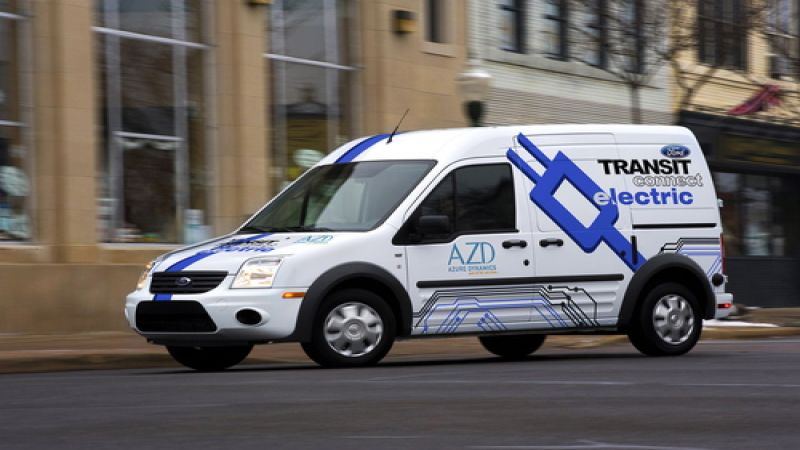The Ford Transit Connect is a popular delivery van type of vehicle, and the internal combustion version is popular world-wide. The 100% electric version driven for this review is in limited production for Ford, by Azure Dynamics. The Transit Connect is primarily targeted to fleet owners, who are expected to be interested in an electric truck for pragmatic business reasons due to savings in "fuel" and maintenance.
The Transit Connect is a light duty truck originally designed for Ford Europe, and is imported to the US from Europe. It has existed since 2002, and the electric version has been on sale since December 2010. It's a very utilitarian vehicle with a plain passenger cabin and a rear cargo area that's highly customizable to carry cargo, tools, workbenches, or even seating to make it into a people carrier. The customizability makes it suitable for any business needing a medium size light duty van.
The driver has good visibility out the large windshield and ample mirrors. The rear view mirror doubles as the display for a backup camera when the transmission is shifted into reverse. You turn on the electric version in a manner similar, for an unknown reason, to how you start a gasoline car. In a gas car you turn the ignition key all the way to where the engine is started, and once the engine starts you release the key so it snaps back to the "on" position. The electric Transit Connect starts the same way, where you turn the key all the way, some dashboard lights turn on, you release the key which snaps back to the "on" position, and you're good to go. For an electric vehicle this is unnecessary as there is no engine that has to start, and it would be sufficient to simply turn the key from an "off" to "on" position, however this design may be to give delivery truck drivers a familiar driving experience.
There is essentially no sound once the vehicle is turned on, but the dashboard lights are on. It's just a matter of putting it into gear via the normal gearshift, pressing the accelerator pedal and going. And boy does it go. One might expect a "delivery van" to have pokey performance, but this van has serious get-up-and-go. There is this "full torque at 0 RPM" effect with electric vehicles that is behind the nice acceleration of the Transit Connect Electric. That "full torque" effect is really up to the vehicle designer, and specifically how they configure the controller and other attributes of the vehicle. In any case the nice acceleration of this electric van was quite fun, and with very little noise as one would expect with an electric vehicle. The vehicle handling is excellent, with a highly responsive accelerator, brake and steering along with excellent visibility.
One of the lesser known side effects of traditional diesel or gasoline commercial trucks is that noise, vibration and exposure to diesel exhaust causes driver fatigue and other negative health effects. The Transit Connect Electric has none of these issues, no noise of any significance, very little vibration, and of course no exhaust of any kind. This should make these vans popular with the drivers.
The cargo area in the test vehicle was filled with racks that Ford Marketing was using to carry their marketing material. It presented a fairly typical use-case of carrying around a quantity of small items in racks. These racks were simply bolted to preconfigured holes in the walls in the cargo area. The cargo area is designed with customization in mind, to suite any of the wide range of needs that businesses have for specialized vehicles.
The 2012 Transit Connect Electric has an electric drive train designed and installed by Azure Dynamics, a company whose history in electric vehicle design dates back to the early 90's. It incorporates a Siemens AC electric motor, an AC controller (inverter) designed by Azure Dynamics, and a battery pack from Johnson Controls (Saft). The battery pack capacity is 28 kilowatt hours, and Azure Dynamics claims this gives a 60-80 mile driving range depending on how heavily loaded the vehicle is. The charging time is 6-8 hours due to the 3.3 kilowatt charger (a 6.6 kilowatt charger would cut charging time to 3-4 hours). The maximum payload is a bit over 1000 lbs in the 129 cubic foot cargo area. Top speed is 75 miles/hr (on flat ground) and it takes 12 secs to go from 0-60 miles/hr. The Azure Dynamic drive train components carry a five year warranty.
Fleet customers have different buying considerations than retail customers. They are able to benefit a lot from savings in fuel and maintenance costs. The fuel cost savings are similar to what we discussed the other day regarding cheaper operating costs for the Volt and Leaf (Consumer Reports: Leaf and Volt cheaper to run than gasoline cars). Essentially because electric drive trains are more efficient than gasoline, the fuel cost is lower for an electric than an equivalent gasoline or diesel vehicle. An additional factor is the reduced maintenance needs because there are no spark plugs or oil to change, or most of the other routine maintenance tasks that must be done on internal combustion vehicles. This means that a business can initially lean to an electric fleet vehicle due to environmental social responsibility concerns, and then be pleasantly surprised to learn these vehicles can help the bottom line as well.
The Transit Connect Electric is available now nationwide via authorized dealers listed on the Azure Dynamics web site.











